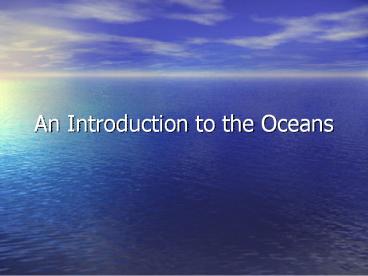An Introduction to the Oceans - PowerPoint PPT Presentation
1 / 23
Title:
An Introduction to the Oceans
Description:
An Introduction to the Oceans AN OCEAN WORLD 71% of Earth s surface 97% of the water on Earth The ocean is Earth s most prominent feature There is only 1 ocean ... – PowerPoint PPT presentation
Number of Views:426
Avg rating:3.0/5.0
Title: An Introduction to the Oceans
1
An Introduction to the Oceans
2
(No Transcript)
3
AN OCEAN WORLD
- 71 of Earths surface
- 97 of the water on Earth
- The ocean is Earths most prominent feature
- There is only 1 ocean we have named its parts
for our convenience - Oceans are only temporary features of a single
world ocean - Average ocean depth is about 4½ times greater
than the average height of the continents above
sea level
4
(No Transcript)
5
Earth is a Water Planet
- Unequal distribution of water with respect to the
equator - 61 of the northern hemisphere
- 80 of the southern hemisphere
- Presence of oceans is function of
- geological activity
- planet's location in relation to sun
- too far away -- water will be in a frozen state
- too close -- water will evaporate
- Earth is in a perfect location to allow water to
be in liquid state
6
(No Transcript)
7
Oceans
- Today's oceans are traditionally divided into 5
large basins - North and South Pacific
- North and South Atlantic
- Indian
- Arctic and Antarctic (Southern)
- Oceans are really interconnected
- Connected to these 5 large basins are smaller,
marginal seas - Mediterranean, Gulf of Mexico, South China Sea,
Red Sea, Caribbean, Baltic Sea, Bering Sea, etc. - Each basin or marginal sea varies in its ability
to support life - climatic differences
- shapes and positions of present-day continents
- Ocean basins consist of
- the deep seafloor (13,000-20,000 ft 4-6 km)
- cover most of Earth's surface (30)
- continents only cover 29
8
(No Transcript)
9
(No Transcript)
10
Distribution of land and sea by latitude
11
Hypsographic Curve Elevation areas above And
below sea-level
12
Bathymetric Chart of the Sea Floor
13
Physiographic Map of the Sea Floor
14
3-D Computer Generated Image of the East Pacific
Rise
15
The Origin of the Oceans
- Differentiation of the Earth
- Densest material sunk to the center of the Earth
- Core alloys of iron high temperatures high
pressures - Mantle less dense than the core, more dense
than the crust - Solid, very hot, near melting point flows like a
very viscous liquid - Makes up 70 of Earths Volume
- Least dense material rose to the surface
- Crust two types
- Oceanic crust higher density basaltic (low Si,
high Fe Mg) - Continental crust Lower density granitic (high
Si, low Fe Mg) - Thus, continents lie above sea level and oceanic
crust lies below sea level because of density
differences
16
Oceans Byproduct of Differentiation
- As the earth warmed and partially melted water
locked in the minerals as hydrogen and oxygen was
released and carried to the surface by volcanic
venting activity - Trapped Volatiles
- Water (H2O)
- Nitrogen (N2)
- Carbon Dioxide (CO2) - most abundant
- Hydrochloric Acid (HCl), source of the chloride
in sea salt (mostly NaCl). - Volcanoes released additional volatiles
throughout the Earth's history - Decreased over Earth history with cooling.
- Oceans formation
- Earth was cool enough for water to condense, 4
billion years ago
17
The Hydrologic Cycle
- Water occurs as a solid, liquid and gas
- Amount of water on Earth is fixed
- The places where water resides are called
Reservoirs - Water constantly moves from one reservoir to
another
18
(No Transcript)
19
Comparison of the amount of water supply held in
each of the major reservoirs If the total earths
water supply was a 55 gallon drum
20
(No Transcript)
21
The Origin of Sea Salts
- Volatile Chemicals released from Earths
interior/volcanoes - Hydrochloric Acid
- Hydrogen Sulfide
- Chemicals leached from crust by weathering
- Ocean Salinity has been constant for 1 billion
years. - input of salts (mainly by rivers)
- output (mainly by deposition of salt as
sediment). - The early ocean, 3.8 billion years ago, was
probably similar in composition to today, except
for changes caused by living things. The most
important of these is the production of oxygen by
plants.
22
The Origin of Life
23
(No Transcript)

